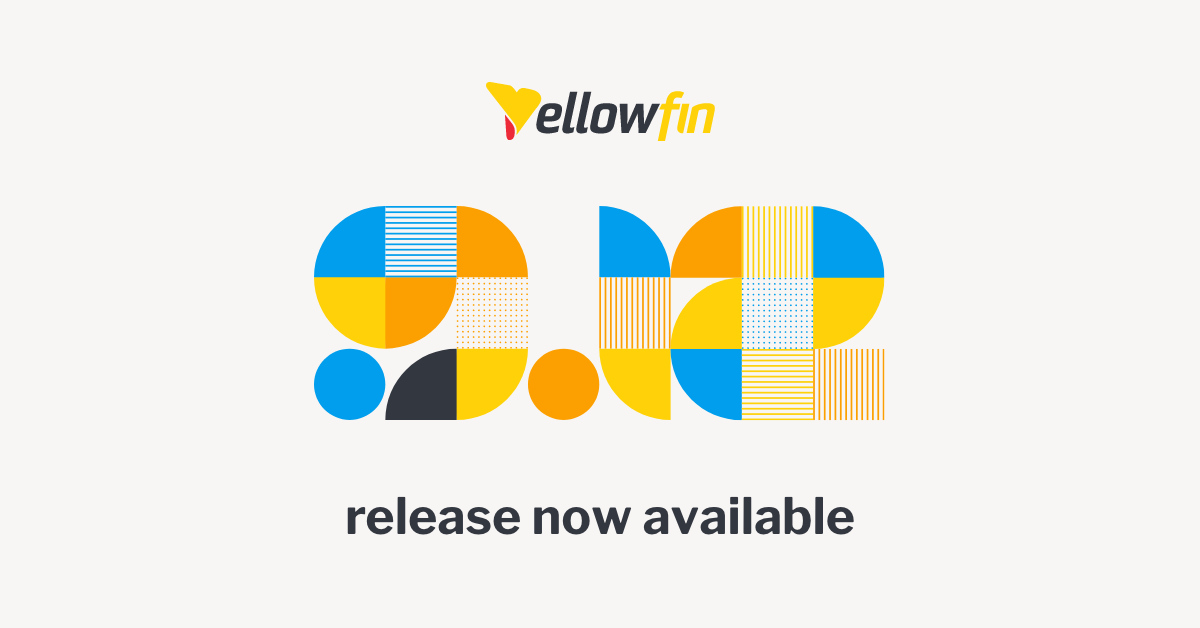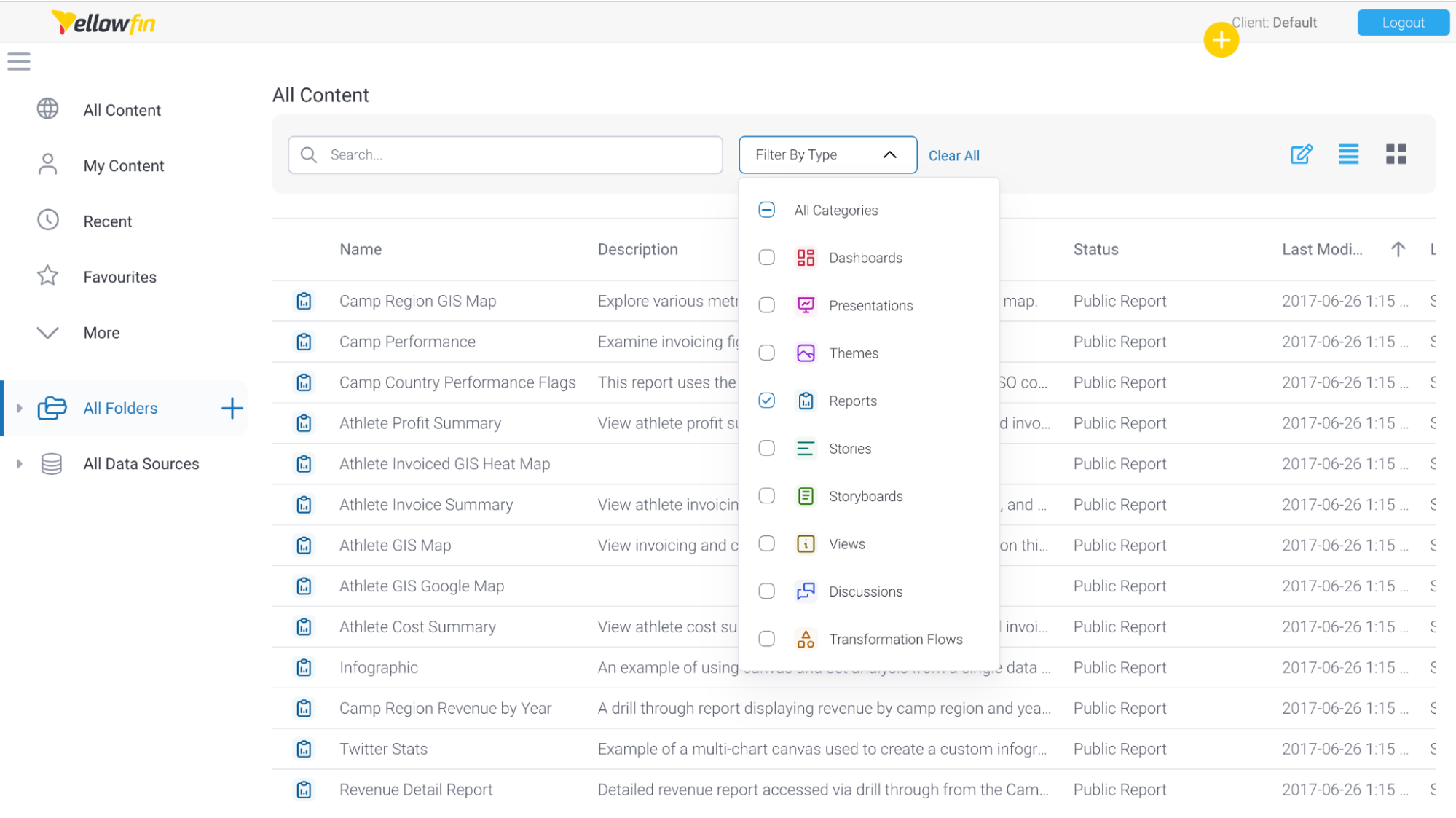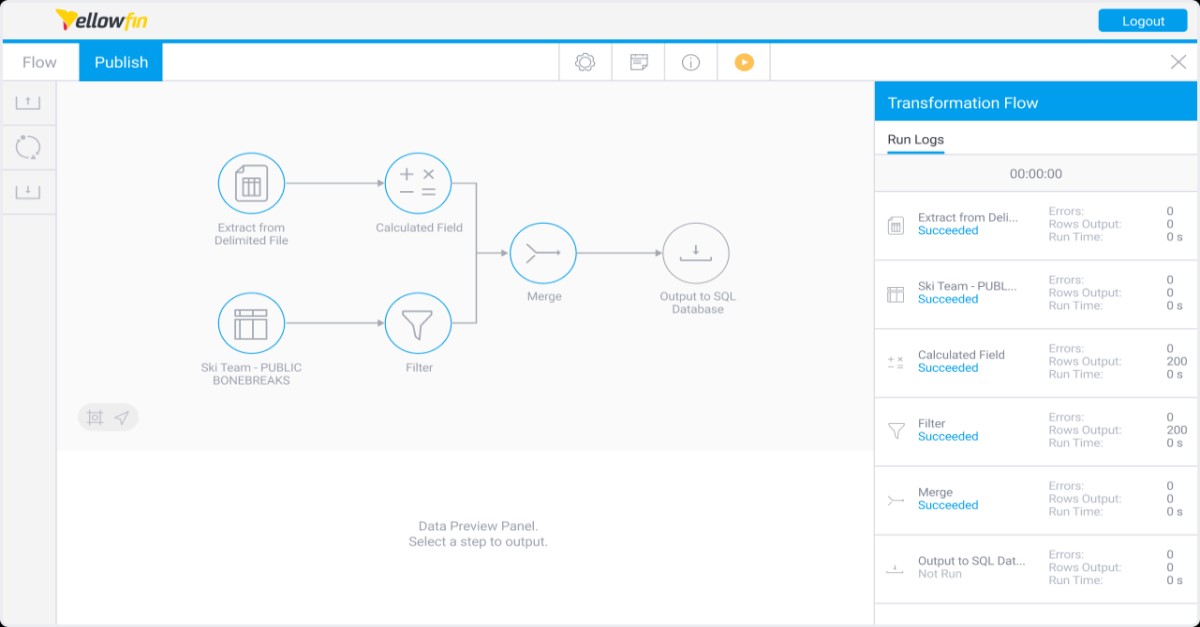
Yellowfin 9.12 Release Highlights
Yellowfin 9.12 is an extensive release that incorporates a large number of bug fixes, additional data connectors, and customer requested enhancements.
The biggest changes in this release focus on Export and Broadcast capabilities. Yellowfin already boasts exceptional reporting capabilities, and 9.12 adds additional features and performance improvements in this area.
Yellowfin also has the ability to connect to just about any source of data. In 9.12, we add specific support for the Qubole Data Lake, as well as making advanced features available for Views built with hand-coded SQL - including calculated fields, advanced functions, parameters and more.
9.12 continues our recent theme of improving the overall user experience by streamlining and modernizing the UI. We have refined aspects of the Browse Page to reduce the number of clicks when searching for content, as well as making improvements to Charts and other areas of the UI. 9.12 also provides additional capabilities for our embedded Customers, with extensions to our REST API to make it even more powerful.
In this blog, we will cover some of the biggest highlights in the 9.12 release. For the full list of updates, please visit our release notes page.
Browse Page Updates
A more modern Browse Page was first introduced in Yellowfin 9.10 (learn more about that here). In this release, we have refined the UI to make it more efficient by reducing the number of clicks to achieve key functions. This includes:
- Tweaking how the Content Type filter drop down operates - reducing the number of clicks it takes to select all or specific content.
- A new user setting to retain the Content Type selections between page visits and across sessions.
- Hiding the recent section when in tile mode when there are no Recent items
- The ability to set 'My Favourites' on the Browse Page as the Users default entry page
- For developers, we added a menu item to the content item menu on the Browse Page to allow the developer to copy the UUID for the item to the clipboard. This is helpful when embedding content using the JSAPI, or manipulating content using Web Services.
Charting updates
Charts are one of the core components of any BI tool. Yellowfin offers a rich range of Charts with an unmatched ability to format and customize those charts. In 9.12, the team has added some additional charting features to enhance the Yellowfin user experience.
This includes:
- Improving how long axis labels are truncated for greater readability on a variety of charts.
- Adding the ability to set the default font for labels in a range of Charts, reducing the time taken to build charts.
- Adding the ability to set bold/italic font defaults for Chart Titles.
- Added the ability to trim dimensions for charts with a lot of dimension values for Stacked Horizontal Bar, Stacked Vertical Column and 3D Stacked Column charts.
See more: Yellowfin Dashboard Gallery - Interactive Charts and Design Examples
Export improvements
Exporting content to external files remains a critical part of BI tools. Yellowfin has added to its extensive capabilities in this area with a broad range of improvements, including:
- Optimizing the performance of Dashboard Exports by eliminating the unnecessary running of reports where the broadcast is for multiple users or groups.
- Added the ability to broadcast a Dashboard using a report-based recipient list - previously this was only enabled for Reports.
- Added the ability to broadcast a report to an external email address typed directly into the recipient list.
- When broadcasting from a report-based recipient list, we added the ability to choose a column for the email address salutation, rather than using the default which was email address.
- Added the ability to export or broadcast a Dashboard to XLS. Each report or chart contained in the Dashboard is added to a separate tab in the XLS file.
- Consolidated all Export Defaults into a single location in the UI under the Administration Console, and moved all legacy export settings onto a new plug-in architecture for easier future maintenance.
- Extended background processing for all exports (previously only PDF) including a progress notification popup that allows long running exports to be canceled or directed to email.
- Enabled Export Defaults to be set differently per client organization.
- PREVIEW: We have added a new PDF export option for Dashboards that exports each report on the Dashboard to PDF and then consolidates those PDFs to a single file. The default report format (as seen when opening the report from the Browse Page) is exported for each report in the Dashboard. This feature is in preview, and its operation may change in future releases.
REST API updates
Yellowfin REST APIs enabled customers to automate key operational tasks such as on-boarding new clients and users. We have made some minor improvements to our REST API at the request of customers. This includes:
- A new endpoint that allows user details to be retrieved based on the users email address - /api/rpc/users/user-details-by-email/email.
- We have also extended /api/admin/users/{userId} to allow the users date format to be set programmatically.
- Import/Export web services have been changed to return the last changed date and time. This allows content to be compared in order to determine what changes need to be replicated between environments.
Views and Data Sources
In Yellowfin, a View is created in order to create a business meta-data layer on top of the technical database structure. Broadly, two types of Views can be created:
- Drag and drop views: This is where the data model is created much like an ER-diagram
- Freehand SQL views: Previously, certain advanced View features were only available on drag and drop views - this included Calculated Fields, Calculated Filters, Parameters, Grouped Data and Date Functions. In 9.12, we have extended these features and they are now available with freehand SQL views.
In this release, we have also certified Qubole data sources. Qubole is a simple, open, and secure Data Lake Platform for machine learning, streaming, and ad-hoc analytics. More details are available at the official Qubole website.
Other miscellaneous updates
We have made a range of other updates as requested by customers, including:
- The ability to hide the "Favourited by" icons on a Dashboard. This helps protect the anonymity of other users.
- Added new predefined data filter options - Last Calendar Year to Date and Last Year Month to Date.
- Added the ability to create copies of Calculated Fields in the Report Builder to improve report building efficiency.
- Added the ability to configure the expiration date of a forgotten password link that is emailed to a user. Previously, it was fixed at 4 days.
More information
The latest releases of Yellowfin can be accessed here.
Release notes for this and every other version of Yellowfin Version 9 can be accessed here.
If you are upgrading from an earlier version of Yellowfin to version 9, be sure to read the Change Management guide which is located here.
For detailed information on how to use Yellowfin, access our Wiki here.

